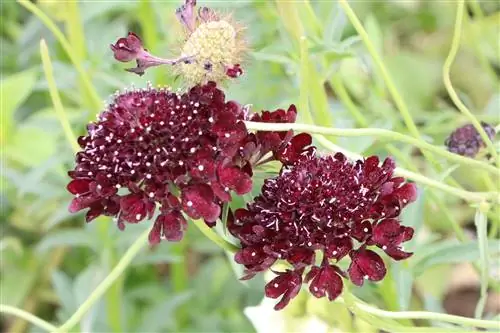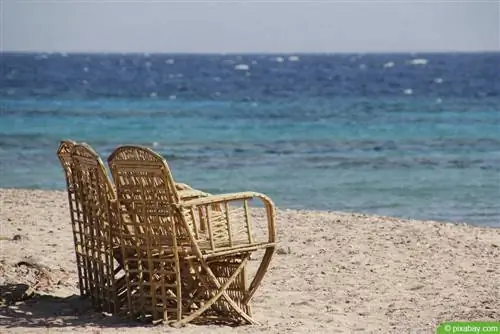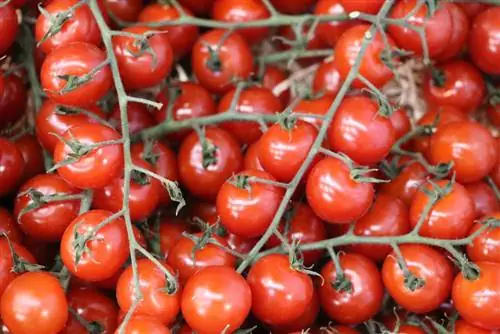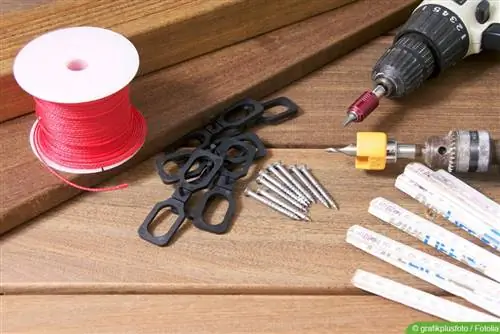- Author admin [email protected].
- Public 2023-12-17 03:39.
- Last modified 2025-01-24 12:45.
The undemanding scabiosis is ideal as a bed and border perennial, but it can also enrich a flower meadow with its abundance of flowers. Its growth height, 30 to 90 cm depending on the variety, makes it a versatile plant. With a color palette ranging from white to pink to purple, they cover a wide spectrum and can be planted in a jumble or in orderly colors, making them a welcome addition to any garden. They don't have any special requirements and hardly need any care. Here we explain to you how cultivation works very easily.
Substrate and soil
The soil should be permeable and not retain moisture. The scabious flowers do not like clayey, heavy soil and this shortens their lifespan. If you have heavy soil, it can easily be improved with sand or gravel. Acidic soils are poison in the truest sense of the word, adding lime helps here, which the scabioses prefer anyway.
- fertilize at the beginning of the season with a good slow-release fertilizer
- annual plants receive some compost when the cuttings are planted
- When dividing perennials, place a layer of coarse sand or gravel under the roots
- can also be cultivated in a pot, soil needs drainage, risk of waterlogging
Location
Sun is the order of the day if you want to cultivate scabious plants in your garden. The little beauties love full sun, but are also happy with partial shade. However, they don't like shade at all, this affects the flowers or even prevents them. The location should also be protected from the wind so that they can develop their full beauty. As a pasture for bees and butterflies, the scabious flower attracts insects and offers them valuable nutrients.
Tip:
Place scabioses with contrasting perennials, such as alpine fairy flower, colorful asters or carpet gypsophila. You will receive a colorful and varied bed border.
Plants
The scabious flower is available in different versions. As a seed it is usually an annual and is sown in April/May; the seedlings are transplanted later. Alternatively, the seeds can be grown in the seed pot so that the small plants can be planted in the bed at an early stage. As a perennial plant, scabiosis is perennial and should be cut back to the ground in autumn. Depending on the variety, flowering extends from June until well into October.
-

As a perennial, scabiosis is a perennial and requires clear pruning When buying, make sure that the balls are well rooted, only then will rich flowers develop
- Dig the planting hole generously, water it generously after inserting it
- Exchange shared perennials with your neighbors to get variety in the garden
- be sure to remove dead flowers, new flower shoots will develop
Tip:
Even if the scabiosis initially looks a bit unsightly as a young perennial because it doesn't have any leaves yet, over time it develops into a decent size. A well-developed ball is crucial.
Watering and fertilizing
The scabious flower needs to be watered regularly when it is dry. If the leaves hang limply, it is high time. Waterlogging must be avoided at all costs; the soil must be well-drained. A lot of water is needed, especially immediately after planting a new perennial, so that the roots can soak up. Fertilizer can be applied to perennials in the form of compost, but a long-term perennial fertilizer that supplies the plants with nutrients throughout the summer has also proven to be effective.
is good as a gap filler, hardly takes anything away from other plants
Propagate
The scabious flower as a perennial grows over time into a proper host that can be easily divided and thus propagated. To do this, the perennial is dug up in spring, divided with a courageous stab of the spade or a sharp knife and immediately put back in its new or old location. This method also ensures that older plants develop more splendidly again.
The annual varieties often propagate by self-seeding, so you should keep an eye on this if you want something else to grow in that spot next year. You can collect the seeds from the adult flowers, store them in a dry, dark place over the winter and sow them again next year. You can also propagate the particularly beautiful plants using cuttings. To do this, shoots about 3 cm long are cut off in spring. The lower leaves are removed, then the cutting is placed in a pot with potting soil and covered with foil. The first roots should have formed after 4 to 6 weeks.
Tip:
When collecting seeds, pay attention to the varieties if you want to have color-sorted plants.
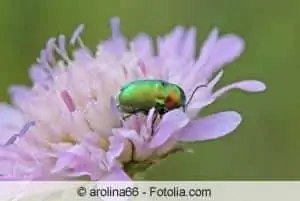
Wintering
The perennial scabiosis plants are hardy and do not need any special protection. Only in very severe frosts is it recommended to cover them with thick leaves or a gardener's fleece. If you grow your scabioses in a pot or bucket, you should also cover them with leaves or fleece in winter, but they do not have to be moved to a protected location.
Diseases and pests
The robust plants are not susceptible to diseases and pests. However, they are sensitive to waterlogging and can therefore develop root rot. A sure sign of this is the leaves drooping. If the soil in this location is generally too wet, drainage should be laid, otherwise the plants will have to be moved to another location.
Recommended varieties
- Butterfly Blue, the pigeon scabiosis with striking blue, approx. 30 to 40 cm high
- Perfecta, the large scabiosis, violet-blue flowers with dark foliage, approx. 60 to 80 cm
- Olymp, annual hybrids in bright colors
- Pingpong, star scabiose, golden yellow, also suitable as a dried flower
- Velvet cabiose, 70 to 100 cm, red, blue and white, also suitable as a cut flower
Conclusion
The scabiosis is an undemanding, robust plant that is suitable for every garden. Due to its variety of colors and shapes, as well as its easy cultivation, it can be used as a bedding or border plant, looks good as an annual in small gaps that are only supposed to grow over later, or enriches any flower meadow with its diversity. The simple method of propagation by division or sowing guarantees new flowers for years to come. A gem for every garden and can be combined perfectly with other perennial flowers.
Profile
- Species/Family: Perennial or annual; belongs to the teasel family (Dipsacaceae)
- Flowering time: Depending on the species and variety, May to October in classic purple, white, pink or almost black
- Foliage: Grey-green to fresh green elongated leaves
- Growth: Bushy clump-like growth with good branching
- Height/width: Depending on the species and variety, 30 to 90 cm high and 15 to 25 cm wide
- Location: Sunny and warm. Permeable soil, rather dry; Depending on the type, more or less nutrient-rich
- Planting time: Any time as long as the ground is not frozen; can also be sown in early spring
- Cut: Spring close to the ground
- Partners: aster, fine ray, rose, sage, yarrow, coneflower
- Propagation: Cut cuttings from late spring to early summer or divide in early spring
- Care: Water when dry; Fertilization depending on the species
- Overwintering: varies depending on the species
Special features
- very popular bee and butterfly pasture
- can also be cultivated in a pot
- tall varieties can be cut well for the vase and last for a long time there
Species
- Double scabiosa (Scabiosa japonica): perennial. Blooms from May to August with flat, densely double flowers in pink or blue. Hardy
- Caucasus scabiosis (Scabiosa caucasica): perennial. Height 60 to 90 cm. Blooms from June to September with large cup-shaped flowers on tightly upright, sometimes branched flower stalks in blue, blue-violet or white. Petals are slightly curled. Bushy clump-like growth. Oblong leaves in gray-green. Can also be sown in early spring. Lover's perennial as it tolerates neither frost nor moisture. Should have a place protected from wind and rain. Goes well with aster, fine jet, rose, sage, yarrow, coneflower. Take cuttings in late spring to early summer or divide in early spring. Nutrient-rich, permeable and calcareous soil, rather dry. Should be somewhat protected from rain. Very sensitive to frost, therefore definitely needs good winter protection. Leave to overwinter frost-free in pots. Comes from the Caucasus
- Velvet scabiosa (Scabiosa atropurpurea): Annual. Height 40-60 cm, 15-25 cm wide. Blooms from mid to late summer with approx. 5 cm large individual flowers in white, blue or violet. Green leaves. Upright, bushy and well-branched growth. 15 to 25 cm wide. Neutral to slightly alkaline soil that should not be too nutrient-rich
- Pigeon scabiosis (Scabiosa columbaria): meadow perennial. Soil rich in nutrients and humus. Hardy
Varieties (selection)
- `Blue Atlas: Caucasus scabious. Pampers the eyes with deep blue flowers
- `Blue Diamonds®: Filled scabiosis. Height 25 cm. Blooms from May to August. Deep blue double flowers
- `Burgundy Bonnets®: height 50 cm. Blooms from June to September with well-double flowers in delicate pink, double center purple with white tips
- `Chile Black: Blooms from June to October in black with a reddish shimmer
- `Clive Greaves: Caucasian Scabious. Striking light blue flowers
- `Miss E. Willmott: Caucasus scabious. Delight with pure white flowers
- `Nana Butterfly Blue: Pigeon Scabious. Height 30 cm. Blooms from May to August with large open flowers with wavy petals in light purple and a distinct large white center
- `Pink Diamonds®: Filled scabiosis. Height 25 cm. Blooms from May to August. Double flowers in bright pink
- `Stäfa: Caucasus scabious. Delighted with dark purple flowers

